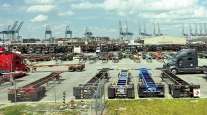Intermodal Freight Volume Moved Back to Pre-Recession Levels in 2010
This story appears in the Dec. 20 & 27 print edition of Transport Topics. Click here to subscribe today.
Intermodal freight volume climbed back late in 2010 to pre-recession levels, driven by cost considerations of both shippers who moved more international import goods and truckers who shifted more freight onto the rails.
“Late summer and early fall saw a recovery in intermodal that exceeded all expectations,” the Intermodal Association of North America said in a November report.
Rail/truck volume in the third quarter reached 3.60 million shipments, the third-highest quarterly total ever reported by IANA, topping the 3.58 million moved in the same quarter of 2008.
Year-over-year growth of 8% in the first quarter accelerated to 17% in the second quarter and 20% in the third quarter. After 11 months, intermodal shipments totaled nearly 12.3 million, more than 15% million, more than 15% above 2009 but still about 5% below that period of 2008.
In its report, IANA recognized the cost pressure on international intermodal shippers.
“The boom in imports, in particular, suggests that retailers are expecting strong volume sales (if not necessarily strong pricing) during the coming holiday season,” IANA said in the report.
Cost also is a key factor for domestic shippers, said Zach England, vice president of intermodal for C.R. England Inc.
“Intermodal is so much more attractive to customers because of lower fuel costs,” he said, adding that shippers are drawn to the reliability of the service.
England supported growth by nearly doubling its refrigerated fleet in 2010 and pledging further growth, an approach that other fleets also have followed.
Another fleet that’s planning growth is Schneider National, whose vice president of intermodal, Steve Van Kirk, cited a third factor that helped truck/rail freight to grow in 2010.
“What you are seeing is demand that is being driven more by manufacturers than consumers,” Van Kirk told Transport Topics. “The core manufacturing business has gone up a bit.”
That strength was underlined in a Dec. 1 report that the Institute of Supply Management’s manufacturing index has signaled expansion for 16 consecutive months.
Van Kirk also hinted that 2011 may present a different picture for shippers who are counting on intermodal to make up for potential truck capacity reductions because of the driver shortage or the disqualification of some drivers by the CSA program.
“There are going to be a lot of [trucking] capacity challenges in 2011,” he said. “That could result in further intermodal growth in the East.”
Eastern intermodal in the 750-mile to 1,000-mile length of haul has grown steadily in markets such as New York-Chicago and Chicago-Atlanta.
Freight moving in that distance range now represents 28.4% of intermodal volume, according to a study by FTR Associates, compared with a total of 25% a decade ago.
Not all was rosy for intermodal in 2010, however.
Shippers and third parties scrambled for capacity on both the international and domestic portions of intermodal movements.
On the international front, ocean carriers cut capacity, allowing the marine companies to reverse losses. For example, Maersk Line, the largest ocean carrier, turned its 2009 loss, the first in at least six decades, into a $2 billion-plus profit in the first three quarters of 2010.
Containers also were in short supply, both internationally and domestically.
IANA attributed the lack of available domestic containers to a halt in acquisitions of that equipment in 2009 and the first half of this year, as providers shied away from capital investments. The shortage was hurt by the ocean carrier capacity squeeze that slowed movement of new containers that were built overseas for U.S. use.
Despite the questions, IANA’s report forecast growth next year because of renewed investment, potential trucking capacity troubles and the fact that domestic intermodal volume didn’t decline, even during the recession.




